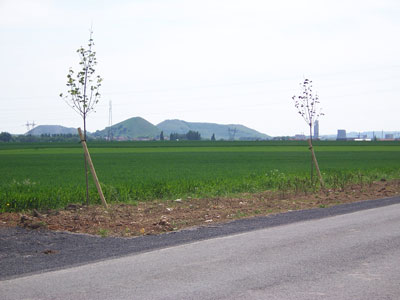
WWII: Maginot Line | Normandy | V-Weapon Sites | Arnhem
Further afield: Crete
| Home Tracing Military Ancestors Travel Advice CWGC Cemeteries Iron Harvest News Book Reviews Glossary Links Contact Me Artois:
 
|
Location 5 Dud Corner CWGC Cemetery and Loos Memorial/Battlefield of Loos
Directions Return back the way you came, taking the first right sign-posted to Festubert (the D166). Proceed through the village and onto Cambrin turning right on the N41 and then a left almost immediately to rejoin the D166. Continue until you reach the major junction at Noyelles and then turn left onto the N43 signposted to Loos-en-Gohelle and Lens. As you reach the top of the ridge you will see Dud Corner CWGC Cemetery and Loos Memorial on your left. Practical Information The memorial lies next to another very straight road where vehicles drive through at quite a speed. Be very careful pulling into and out of the parking area and exiting/entering your vehicle. This region was a major coal mining area before and after the First World War and the area is littered with collieries and slag heaps these make useful reference points when exploring as the surrounding farmland is fairly unremarkable.
Getting Your Bearings Dud Corner CWGC Cemetery sits atop the Grenay Ridge from where the British launched their offensive on the morning of 25th September 1915. The scene of the subsequent struggle, which became known as the Battle of Loos, can be clearly viewed from the top of the observation platform on the roof of the left-hand pavilion. Taking the main surrounding features in a clockwise motion looking firstly back down the N43 towards B้thune (images 1-7 below):
Dud Corner CWGC Cemetery and Loos Memorial to the Missing (images 8-11 above) Designed by Sir Herbert Baker, who was also responsible for Tyne Cot CWGC Cemetery at Ypres, the memorial contains the names of 20,712 officers and men killed in this area from the start of the Battle of Loos to the end of the war, and who have no known graves. Particularly poignant amongst them is Lieutenant John Kipling of the 2nd Irish Guards, son of the writer Rudyard. The cemetery contains around 1,800 graves of whom two-thirds are unidentified. Historical Notes and Eyewitness Account The Battle of Loos was the first use by the British of poison gas as a weapon of war and specially trained gas units where positioned along the British front line to release it. However, at the crucial moment early on the morning of 25th September, the wind dropped and when the taps on the gas cylinders were opened the noxious cloud failed to drift towards the Germans as hoped. In fact in many divisional sectors, such as here on the 15th Division front, the gas wandered back into the British trenches engulfing the troops about to attack! Despite this early setback and a sudden German bombardment at zero hour, the Scots of the 9th Black Watch and 8th Seaforth Highlanders swarmed forward to take the Lens Road Redoubt. They were irresistible as an observer of the 9th Black Watch's assault on the Lens Road recalled in the regimental history: "No one present will ever forget that attack. As one the leading two platoons of 'A' Company leapt on the parapet and, making their way through the British wire, steadily advanced toward the German front line, followed by the remainder of the Battalion at regular intervals. It seemed impossible to realise that these lines of disciplined soldiers had been, twelve short months before, almost all civilians. Perfect steadiness prevailed, regardless of the heavy fire which, coming more especially from the Lens Road Redoubt, swept the ground over which they had to cross. There was no shouting or hurry; the men moved in quick time, picking up their dressing as if on ceremonial parade. The distance to be crossed varied from 80 to 200 yards and, despite the fierce fire, not a line wavered or stopped." Extract from Loos Hill 70 by Andrew Rawson, 2002 Pen & Sword Books. Whilst it had caused some disorganisation in the British trenches before the attack, the gas did have the desired effect of frightening many of the Germans into a retreat out of their front line trenches at this point, thus assisting the Black Watch and Seaforths in their advance. Once captured, the victorious highlanders carried on into the valley beyond bound for Loos village. Here the Germans were taken completely by surprise and failed to hold the trenches that defended the village. The Scots crashed through and began to fight house to house in the village with grenade, rifle and revolver. By 9:00am the advance was on again with a mixed group of around 1,500 men including the support battalions of 7th Cameron and 10th Gordon Highlanders scaling Hill 70. The Germans on the summit in the redoubt ran for cover from the onslaught with the highlanders hard on their heels. On reaching the top of Hill 70, however, they came within sight of the defenders of the German second line which now exacted a heavy toll on the exposed slopes with intense rifle and machine gun fire. The highlanders began to dig in as best they could to await reinforcements. Unfortunately, by the time these arrived and new attacks organised, the German defence had recovered and was robustly fighting back. The opportunity of exploitation was lost and later in the afternoon Hill 70 was recaptured. |
|||||||

